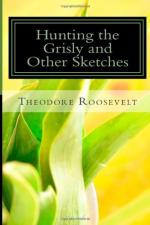Nevertheless it is no easy task to determine how many species or varieties of bear actually do exist in the United States, and I cannot even say without doubt that a very large set of skins and skulls would not show a nearly complete intergradation between the most widely separated individuals. However, there are certainly two very distinct types, which differ almost as widely from each other as a wapiti does from a mule deer, and which exist in the same localities in most heavily timbered portions of the Rockies. One is the small black bear, a bear which will average about two hundred pounds weight, with fine, glossy, black fur, and the fore-claws but little longer than the hinder ones; in fact the hairs of the fore-paw often reach to their tips. This bear is a tree climber. It is the only kind found east of the great plains, and it is also plentiful in the forest-clad portions of the Rockies, being common in most heavily timbered tracts throughout the United States. The other is the grisly, which weighs three or four times as much as the black, and has a pelt of coarse hair, which is in color gray, grizzled, or brown of various shades. It is not a tree climber, and the fore-claws are very long, much longer than the hinder ones. It is found from the great plains west of the Mississippi to the Pacific coast. This bear inhabits indifferently lowland and mountain; the deep woods, and the barren plains where the only cover is the stunted growth fringing the streams. These two types are very distinct in every way, and their differences are not at all dependent upon mere geographical considerations; for they are often found




